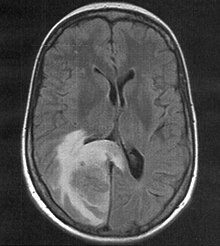User:Mr. Ibrahem/Cerebral edema
| Mr. Ibrahem/Cerebral edema | |
|---|---|
| Other names | Brain edema,[1] cerebral oedema, brain swelling |
 | |
| MRI (T2 flair) showing a brain metastasis with surrouding edema | |
| Specialty | Neurology, neurosurgery |
| Symptoms | Headaches, vomiting, sleepiness, trouble seeing, decreased level of consciousness[1] |
| Complications | Seizures, permanent brain injury[2] |
| Types | Vasogenic, cellular, osmotic, interstitial[2] |
| Causes | Stroke, traumatic brain injury, subdural, subarachnoid, epidural, or intracerebral bleeding, hydrocephalus, brain cancer, brain infections, severe high blood pressure, high altitude, liver inflammation, carbon monoxide poisoning, low blood sodium[2][1] |
| Diagnostic method | Based on symptoms, examination, medical imaging[3] |
| Treatment | Proper positioning, increasing the breathing rate, osmotic therapy, diuretics, or corticosteroids, surgery[2] |
| Frequency | Relatively common[2] |
Cerebral edema is swelling of the brain.[2] Symptoms may include headaches, vomiting, sleepiness, trouble seeing, and decreased level of consciousness.[1] Irregular breathing may occur as the brain is about to herniate.[1] Complications may include seizures and permanent brain injury.[2]
Causes include stroke, traumatic brain injury, subdural, subarachnoid, epidural, or intracerebral bleeding, hydrocephalus, brain cancer, brain infections, severe high blood pressure, high altitude, liver inflammation, carbon monoxide poisoning, and low blood sodium.[2][1] Diagnosis is based on symptoms, examination, and medical imaging.[3] An ICP monitor may help determine the severity.[2]
The treatment is primarily directed at the underlying cause.[2] General efforts may include proper positioning, increasing the breathing rate, osmotic therapy, diuretics, or corticosteroids.[2] Surgery, known as a decompressive craniectomy, may be done in severe cases.[3] Outcomes are variable and depend, in part, on the underlying cause.[2] If a person in unconscious outcomes are frequently poor.[2]
Cerebral edema is relatively commons.[2] The exact frequency is unclear as its presence may not always be clear.[3] For example, about a third of people develop brain edema within a month of an ischemic strokes and it occurs in about 20% following a subarachnoid bleed.[4][5] Treatments for cerebral edema have been described at least as early as the 900s by the Persian physician Haly Abbas.[6]
References[edit]
- ^ a b c d e f Leinonen, Ville; Vanninen, Ritva; Rauramaa, Tuomas (2018), "Raised intracranial pressure and brain edema", Handbook of Clinical Neurology, 145, Elsevier: 25–37, doi:10.1016/b978-0-12-802395-2.00004-3, ISBN 978-0-12-802395-2, PMID 28987174
- ^ a b c d e f g h i j k l m n Nehring, SM; Tadi, P; Tenny, S (January 2020). "Cerebral Edema". PMID 30725957.
{{cite journal}}: Cite journal requires|journal=(help) - ^ a b c d Raslan A, Bhardwaj A (2007). "Medical management of cerebral edema". Neurosurgical Focus. 22 (5): E12. doi:10.3171/foc.2007.22.5.13. PMID 17613230.
- ^ Wu, Simiao; Yuan, Ruozhen; Wang, Yanan; Wei, Chenchen; Zhang, Shihong; Yang, Xiaoyan; Wu, Bo; Liu, Ming (December 2018). "Early Prediction of Malignant Brain Edema After Ischemic Stroke". Stroke. 49 (12): 2918–2927. doi:10.1161/STROKEAHA.118.022001. ISSN 1524-4628. PMID 30571414.
- ^ Mohr, J. P.; Wolf, Philip A.; Moskowitz, Michael A.; Mayberg, Marc R.; Kummer, Rudiger Von (2011). Stroke E-Book: Pathophysiology, Diagnosis, and Management. Elsevier Health Sciences. p. PA606. ISBN 978-1-4377-3780-6. Archived from the original on 2021-08-28. Retrieved 2020-12-03.
- ^ Ellenbogen, Richard G.; Sekhar, Laligam N.; Kitchen, Neil (2017). Principles of Neurological Surgery E-Book: Expert Consult - Online. Elsevier Health Sciences. p. 8. ISBN 978-0-323-46127-6. Archived from the original on 2021-08-28. Retrieved 2020-12-03.
